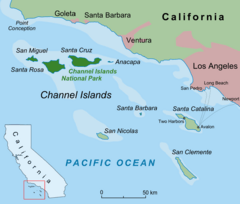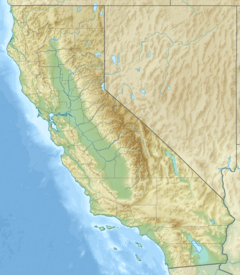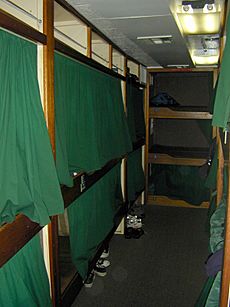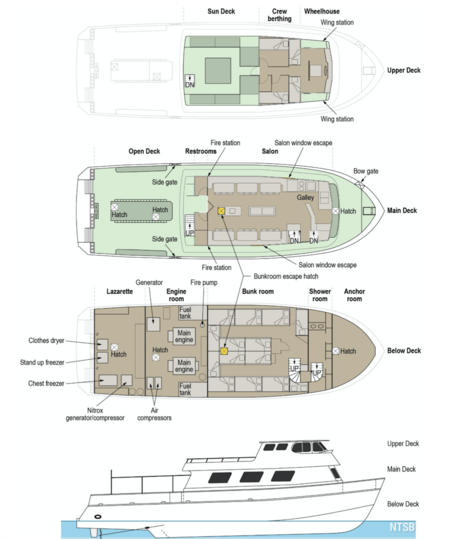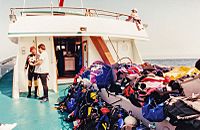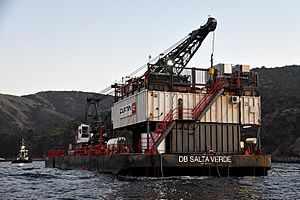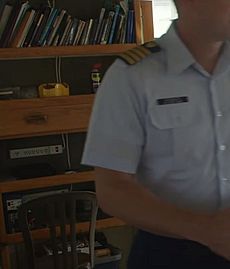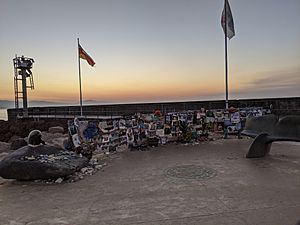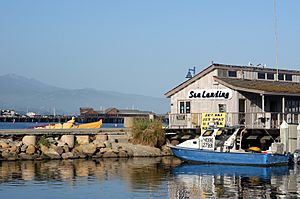Sinking of MV Conception facts for kids
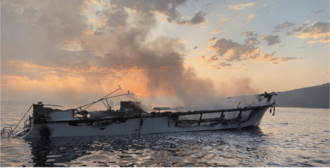
Conception at dawn on September 2, 2019, shortly after the fire was put out (photo by Ventura County Fire Department)
|
|||||||
| Date | September 2, 2019 | ||||||
|---|---|---|---|---|---|---|---|
| Time | About 3 a.m. PDT UTC−07:00 | ||||||
| Location | Platts Harbor, Santa Cruz Island, California, United States | ||||||
| Cause | Fire | ||||||
| Outcome | (See Aftermath section) | ||||||
| Deaths | 34 | ||||||
| Non-fatal injuries | 5 | ||||||
|
|||||||
The sinking of MV Conception happened on September 2, 2019. This 75-foot (23 m) dive boat caught fire and later sank. It was off the coast of Santa Cruz Island, California, in the United States. The boat was anchored for the night at Platts Harbor. This is a small bay on the island's north shore. A fire started shortly after 3 a.m. At that time, 33 passengers and 1 crew member were sleeping below deck. Five crew members, who slept on the top deck, managed to escape. Sadly, everyone else on board died. The fire forced the surviving crew to jump overboard. They made an emergency call to the Coast Guard. They also tried to warn the passengers. The crew then used the Conception's small boat to reach a nearby vessel. From there, they made another radio call for help. The United States Coast Guard led the rescue and recovery efforts.
This event was the worst maritime disaster in California since 1865. It was also the deadliest in the United States since 1989. For transportation-related disasters in the U.S., it was the deadliest since 2009.
Contents
About the Conception Dive Boat
The motor vessel (MV) Conception was a 75-foot (23 m) liveaboard boat. It was built in Long Beach, California, and launched in 1981. Truth Aquatics owned the Conception and two other dive boats. They offered trips from Santa Barbara Harbor. These trips allowed groups of divers to explore the Channel Islands. These islands are near the coast of Southern California.
The Conception was rented by Worldwide Diving Adventures (WDA). It was on a three-day scuba diving trip for the Labor Day holiday weekend. This was a very popular tour package. The boat had been fixed up for over $1 million after it was stolen and ran aground in 2005.
Boat Design and Safety Rules
Federal and international rules require larger boats to be made of fire-resistant materials. They also need fire sprinklers and smoke detectors. These systems must be connected to the boat's electronics. However, because of its age and size, the Conception did not have to follow these rules. It was less than 100 GT and had fewer than 49 beds. The boat was made of wood covered with fiberglass. This was allowed by rules from 1978. At the time of the fire, the Conception was thought to follow all rules. Recent Coast Guard checks in 2018 and 2019 found no major problems. The boat could carry up to 103 people: 4 crew and 99 passengers. One crew member was supposed to be on patrol at all times when passengers were sleeping.
The boat had three decks. The upper deck had the wheelhouse, crew sleeping areas, and a sun deck. The main deck, below the upper deck, had a large cabin. This cabin included a kitchen (galley) and a lounge (salon) with seating. The salon was reached from the back of the boat. It had a hallway with restrooms. The lower deck had beds for up to 46 people. There were 13 double bunks and 20 single bunks. One bunk was for crew. This deck also had showers, the engine room, and other machinery spaces. The rest of the crew's beds were on the upper deck.
The main way for guests to get to the lower deck was a front stairway. This stairway connected to the galley and main deck cabin. The boat's designer said there were two exits from the lower deck bunk room. One was the front stairway. The other was a back escape hatch above a bunk. This hatch led to the salon. After using the back hatch, a person would still be inside the main deck cabin. They would be about 3 to 4 feet (0.91 to 1.22 m) from the exit to the main deck. Some past passengers only remembered the front stairway. They did not remember being told about the back emergency escape hatch. The Santa Barbara County Sheriff said both exits seemed to be blocked by fire during the disaster.
The Fire Incident
The Voyage Before the Fire
The Conception left Santa Barbara Harbor at 4:04 a.m. on August 31. By 8:30 a.m., it arrived at a dive spot near Albert Anchorage. This was on the south side of Santa Cruz Island. The crew had six people: the captain, a second captain, two deckhands, and two galleyhands. When they arrived, the first deckhand gave a safety briefing. It was interrupted when a passenger fainted. After the passenger felt better, the captain finished the briefing. The Conception then sailed to the east side of the island. It anchored in Smuggler's Cove for the night. The crew had a rule to turn off the power to the kitchen burners at night.
On September 1, the trip included a night dive at Quail Rock. This was on the northern coast. Divers returned between 8:30 p.m. and 9:30 p.m. They put flashlights, cameras, and photo strobes on two tables in the salon. Some of these were plugged in to charge. Cell phones and tablets were also charging. The first galleyhand remembered seeing "sparks" when he plugged in his phone that night.
How the Fire Was Discovered
On the night of the fire, the second galleyhand woke up around 1:30 a.m. He went to the kitchen to wash dishes. He did not see anyone else awake. After taking out the trash, he went back to sleep around 2:35 a.m. He slept in the crew quarters on the upper deck. Later, he woke up to a popping sound. He thought it was a confused crew member or passenger. When he got out of bed to help, he found a huge fire on the main deck below. The fire had already spread to the back of the upper deck. It blocked their way to the main deck. The back ladder was already on fire.
The second galleyhand went back to wake the other crew members on the upper deck. Two emergency calls (mayday calls) were made around 3:14 a.m. from the Conception's wheelhouse.
Crew's Escape and Attempts to Help
The five crew members sleeping on the upper deck jumped to the main deck. One broke his leg. The second galleyhand was the first to go down. He tried to get fire extinguishers, but smoke and flames blocked his way. The first deckhand followed. The first galleyhand also jumped, landing badly and breaking his left leg.
The ship's captain said the back escape hatch was on fire. The surviving crew could not help the passengers and the second deckhand. They were all sleeping in the lower deck beds. The first deckhand and second galleyhand tried to get into the main deck cabin through a front window. The window was not hot, but it would not open. Only thick smoke could be seen. Flames stopped the crew from reaching the salon along the outside walkways. They could not rescue the trapped passengers.
Mayday Calls and Leaving the Boat
At this time, the captain was sending mayday signals. He told the Coast Guard, "39 POB [people on board]. I can't breathe. 39 POB. Platts." The captain then jumped into the ocean. Smoke was behind him, so some crew thought he was on fire. The second captain followed him to help. The first deckhand remembered an axe in the wheelhouse. But the captain was the last to leave, so it could not be reached. The fire blocked access to the firefighting stations. Trapped by the fire, the first deckhand and second galleyhand followed the captains into the water.
All five crew members jumped into the ocean from the front of the boat. The second captain, first deckhand, and captain got the boat's small inflatable boat (skiff). After picking up the other crew, they paddled about 200 yards (180 m) to a nearby boat, the Grape Escape. Both the second captain and first deckhand went back to the Conception's back. They both tried to get to the lower deck but could not. The first deckhand tried to enter the engine room to start the fire pump. But the room was full of smoke. The second captain saw the burning boat still had power. They used the electric winch to lower the skiff. Once the skiff was in the water, the captain told them to leave the Conception again.
The surviving crew sent another mayday alert from the Grape Escape at 3:29 a.m. The second captain and first deckhand went back to the Conception in the skiff to look for survivors. While waiting for help, small explosions were heard from the Conception. The crew thought these were pressurized dive tanks bursting from the heat. One distress call from the Conception at first seemed to suggest someone below deck was awake. A man's voice was recorded screaming "Mayday! Mayday! Mayday! I can't breathe!" However, Glen Fritzler, the owner of Truth Aquatics, said the first mayday calls were made by the captain from the wheelhouse before he left the boat.
Fighting the Fire and Sinking
When officials arrived, they had trouble fighting the fire. The boat was in a remote spot with few firefighting tools. The fire was spreading fast and kept flaring up. The Conception's anchor line burned through. The boat started to drift towards the island. This raised fears it might set fire to plants on shore. Also, the Conception had drifted into shallower water. Most fireboats could not get close enough to fight the fire.
Two initial response boats had portable pumps. But the Ventura County Fire Department (VCFD) decided they would not work. They started searching the water for survivors. The fire was too big for anyone to be alive on board. Boat 15 became the main firefighting boat when it arrived at 4:55 a.m. It had stronger pumps and carried firefighting foam. A helicopter searched for survivors using a special camera. It could see seagulls from 1⁄2 mi (0.80 km), but no survivors were found.
To fight the fire, a line was attached to the still-burning Conception. It was towed to deeper water by Retriever II. Boat 15 reported the fire was out by 5:23 a.m. But hot spots kept reigniting. The fire had burned down to the water line. The hull was also full of water from firefighting efforts. The boat was not stable enough to put pumps on board to remove the water. Conception was then towed back to shallower waters to help with its recovery. But the boat sank stern-first about four hours after the fire started, at 6:54 a.m. It landed upside-down at a depth of 64 feet (20 m). This was about 20 yards (18 m) from the north shore of Santa Cruz Island. The first victim was found at 8:04 a.m.
The Coast Guard cutter Narwhal arrived at 8:32 a.m. It took over command of the scene. It stayed at Platts Harbor for four days to help with rescue and recovery. The Coast Guard stopped searching for survivors at 9:40 a.m. on September 3. They had searched 160 sq mi (410 km2) of water for 23 hours.
Investigation into the Fire
The National Transportation Safety Board (NTSB) started an investigation on September 3. On September 11, the Coast Guard announced it would hold a formal investigation. This Marine Board of Investigation (MBI) would look into what caused the fire. It would also check if actions by certified people or government staff played a role.
The wreck was examined after it was brought to Port Hueneme on September 13. The examination finished on September 27. But no immediate cause of the fire was found. Some parts of the boat were sent to labs for more tests.
What Caused the Fire?
The NTSB expected to find the cause after 12 to 18 months. One surviving crew member thought the fire might have started in the boat's salon. This is where cell phones and cameras were plugged in to charge overnight. The boat's designer thought the fire might have started in the bunk area. It could have been sparked by a lithium battery. Boats built when the Conception was made did not have electrical systems for many rechargeable devices. Today, passengers bring many phones, cameras, and lights. All these devices charging at once might have overloaded the circuits. Or, the devices' lithium-ion batteries might have overloaded. In 2018, on a sister ship called Vision, two passengers saw a battery and charger catch fire. They unplugged it and put it in water.
The NTSB planned to take parts of any charging devices to their headquarters for more study. On September 10, the Coast Guard told boat owners to limit "unsupervised charging of lithium-ion batteries and extensive use of power strips and extension cords."
Official Conclusion on the Cause
The NTSB concluded that the main cause of the accident was that Truth Aquatics, Inc., did not properly watch over its boat and crew. This included not making sure a roving patrol was kept. This allowed a fire, whose cause is unknown, to grow without being noticed. The fire started near the back salon on the main deck.
Aftermath and Changes
California Governor Gavin Newsom praised the emergency workers. He also offered his sympathy to the families affected.
A temporary memorial was set up outside Sea Landing. This was the office of Truth Aquatics in Santa Barbara Harbor. A vigil was held on September 6. First responders, religious groups, and divers took part. The memorial was moved in November 2019. It is now at the end of the harbor breakwater. It is next to the "Lost at Sea" memorial. A permanent memorial for the victims was dedicated on September 2, 2020. This was the first anniversary of the disaster. The victims' names are on a plaque. Another memorial is being designed for a museum. It will use one of the propellers from the Conception.
Truth Aquatics stopped operating its other two boats after the disaster. This stop became permanent in October 2019. In June 2020, the Coast Guard gave an award to Paul Amaral. He was the captain of the TowBoat US vessel that towed the burning Conception to deeper waters.
Lessons Learned and New Rules
The NTSB suggested the Coast Guard update its rules for small passenger vessels. They recommended stricter rules for smoke detectors in all passenger areas. They also suggested a way to check that roving patrols are actually happening. Another idea was to require a second escape path. A key recommendation was to make boat operators have a safety management system. This idea had been suggested before after other accidents.
In February 2021, Vice Admiral Scott Buschman of the Coast Guard agreed with the NTSB's ideas. He said the Coast Guard inspected boats with overnight accommodations after the fire. The results will be used to update inspection programs.
The United States House of Representatives Subcommittee on Coast Guard and Maritime Transportation held a meeting on November 14, 2019. They talked about commercial and passenger vessel safety. Brian Curtis from the NTSB said the investigation was still going on. It would look at the wreck, rules, fire alarms, escape routes, training, and company policies. Members of the Subcommittee asked the Coast Guard about a news story. The story said the Coast Guard often did not follow safety suggestions from the NTSB. Rear Admiral Richard Timme promised the Coast Guard would "wholly fulfill our regulatory oversight role to keep the maritime public safe." He said they would adopt new rules quickly.
Rep. Salud Carbajal, Rep. Julia Brownley, and Sen. Dianne Feinstein introduced a bill in December 2019. It was called the Small Passenger Vessel Safety Act of 2019. It aimed to make some of the suggested changes into law. These bills have become part of the National Defense Authorization Act for Fiscal Year 2021. The families of the victims continue to ask for laws to make safety better. They want improved fire and safety training and more monitoring devices.
See also
- List of maritime disasters in the 21st century
- List of shipwrecks in 2019
- List of transportation fires


